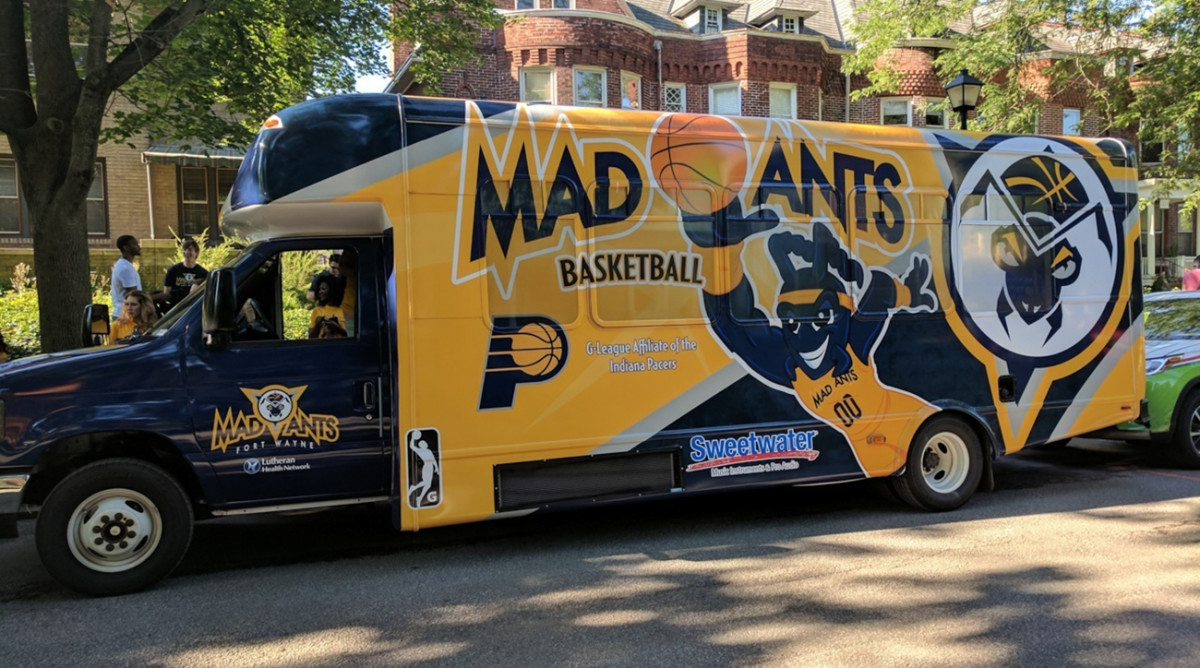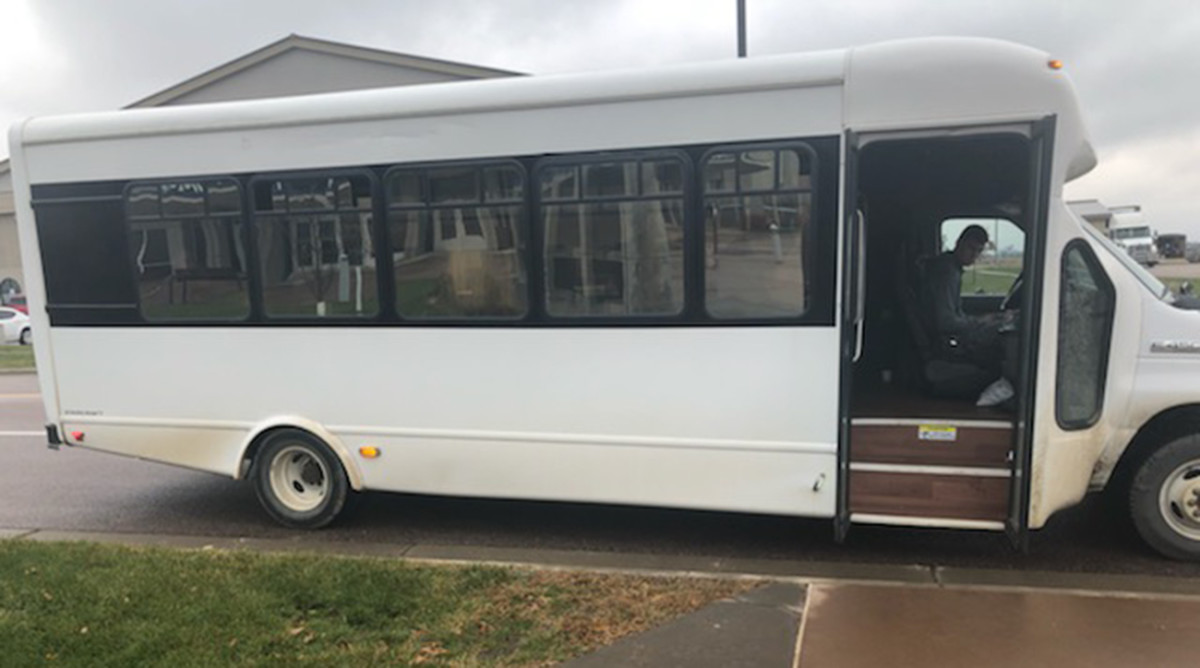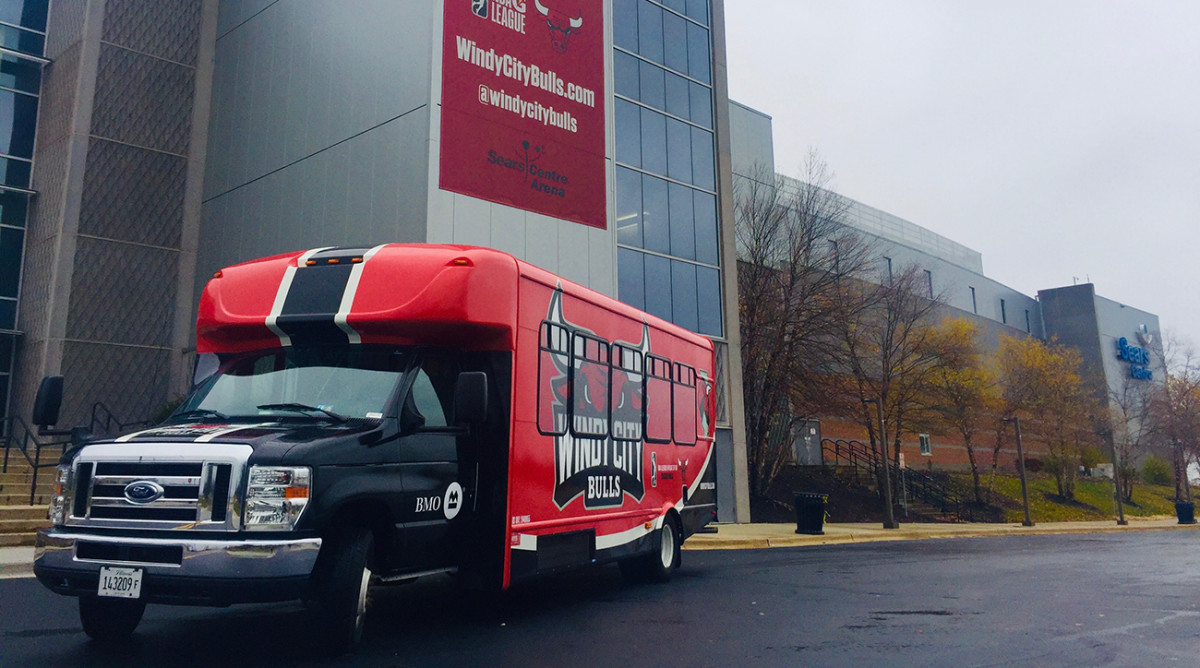License to Hoop: The Wonky World of G-League Bus Driving

The engine was still running, but the door was locked. Scott King peered through the windows. The bus’s keys mocked him from inside the ignition. “I’m like, ‘Aw, s---,’” King remembers.
As the 2017–18 basketball operations intern for the Fort Wayne Mad Ants, the G-League affiliate of the Indiana Pacers, King abandoned his previous job in supply chain compliance to assist on the court during practice, cut film in the video room, and… drive the team’s 21-seat bus.
WOO: Which prospects stood out at the Champions Classic?
On this particular November morning, King wheeled the Mad Ants’ “Ant Mobile” over to Fort Wayne International Airport, tasked with picking up the team’s opponent for their home opener, the Greensboro Swarm. He arrived 30 minutes early. Nervous about his first shuttle of the season, King decided to double-check that the back of the bus was cleared and prepped to store the Swarm’s full batch of luggage. Only 10 minutes before the visitors landed, the former Stony Brook reserve forward realized he locked himself out of the vehicle in the process.
King frantically sprinted across the driveway, locating a police officer and airport security and begging the officials to help pry open the door. Cam Twiss, Greensboro’s general manager, texted King shortly after to announce the Swarm’s arrival. “I’m freaking out,” King says. He scurried into the airport. The Swarm’s bags began to trickle out onto the conveyor belt. Just as the restless players began wondering when they could head out to the bus, King saw the cop wedging open the bus door. “I literally had five seconds to spare,” King says. “I thought I was gonna be fired day one.”

The G-League purchased identical buses for each developmental association team ahead of the 2016–17 season, dropping $1.8 million on a fleet of StarCraft vehicles. Wayne Rappaport, the league’s CFO even met Layne Coscorrosa at the Indiana plant of Northwest Bus Sales, Inc. to make certain that the buses fit exactly what the G-League preferred. “[He] needed to ensure the players comfort and safety,” Coscorrosa wrote in an email.
Team buses have long been a staple of the G-League. Interns have chauffeured players from their apartment complexes to games, practices, group barbershop outings, and grocery store runs for as long as anyone can remember. “I would do my rounds every morning and go from apartment to apartment,” says George Galanopoulos, a Dallas Mavericks video coordinator who interned for the Bakersfield Jam in 2011–12.
Back then, the now-defunct Jam were privately owned, devoid of an exclusive NBA affiliate partner, and Galanopoulos carpooled the Bakersfield players in the classic, three-row, 12-seat, all-white Ford vans you’ve likely rode in at summer camp or for a hotel’s complimentary airport shuttle. He set up a group text containing the entire roster. In the days before Uber, Galanopoulos transported players to any everyday activity that required a ride.
For most of Bakersfield’s road trips, flights out of LAX presented a far cheaper option, so Galanopoulos would pilot the team two hours south to Los Angeles, return home, then cruise back down I–5 upon the Jam’s return. (Interns typically do not travel for road games.) Those rides could have been viewed as torturous, but players swapped the auxiliary cord and gabbed like an episode of "The Shop". “It might sound corny, but that was where you really saw the team camaraderie,” Galanopoulos says. “And that was cool to be a part of that. It was our little thing.”
Ben Resner, currently the Mad Ants’ head video coordinator, bussed the Canton Charge during his 2014–15 internship. “I didn’t have any practice or anything. It was just… you’re driving,” Resner says. The bus lived at Canton’s practice facility, leaving Resner to begin each morning driving his personal car from the team’s apartment complex, revving up the bus, and shuttling back over to the complex to scoop the team’s players. If the Charge left town for a road trip and left the bus parked, the vehicle would collect mounds of Ohio snow Resner had to clear off the windshield with his elbows and a scraper before collecting rival teams at the airport.
“That’s the benefit of it,” Resner says. “It gives you an opportunity to connect with the other team.” Those commutes can introduce interns to G-League executives they will later interview with at Summer League. Resner once witnessed an opponent’s brass discussing whether or not to fine a player for being 10 minutes late, showcasing the all-encompassing responsibilities of basketball operations staffs. Some rival teams now tip interns who show particular zeal.
A handful of teams have left the buses plain white, like in Sioux Falls.

The creative programs, like Fort Wayne above and Windy City below, have "wrapped" their units into a rolling team advertisement.

A few franchises still own larger buses, leaving the league-wide vehicle for their visitors’ travel. The Rio Grande Valley Vipers have long employed Benny the Bus Driver, who steers the team’s personalized coach bus that features a bathroom and electrical outlets. However, once the G-League instituted the uniform buses, interns were also required to study for and pass their state’s Commercial Driving License test on top of their basketball responsibilities.
Once he arrived in Fort Wayne in the September of 2017–18, King would assist the Mad Ants’ coaching staff in preparing for the upcoming G-League draft, watching film on frontcourt players and gathering intel from their college coaches. Then, he’d retreat home to study for the CDL. First, King needed to obtain an Indiana license, which merely required passing the standard written driving test he had completed in high school back in New Hampshire. The CDL itself called for completing two written tests, the initial exam consisting of simple safety measures like how to legally cross railroads, the second breaking down the nuts and bolts of the bus.
The CDL also demanded King pass an inspection, where he walked around the entire vehicle, correctly labeling the machine’s braking system, segments of the engine under the hood, and checking the exhaust. “At night I’d just go around the bus probably four or five times and keep reciting it until it was perfect,” King says. Finally, King completed the driving portion of the process, a 30-minute test including parallel parking, angle parking and driving reverse in between strict lines for 100 yards. He practiced with fellow Mad Ants staffer, Alex Cerda, who is now a video intern with the Clippers, in the parking lot of an abandoned Home Depot.
2019 Big Board: Top 60 Prospects as College Basketball Tips Off
Josh Kreibich, the Windy City Bulls’ manager of basketball operations, says the state of Illinois requires a full medical physical and drug test in addition to the requirements King completed in Indiana. “There’s a couple hoops that you have to jump through,” Kreibich says. “But see a job, do a job.” Kreibich interned for Windy City in 2016–17, when he’d be instructed to shuttle the G-League players to Chicago’s Advocare Center practice facility so the Windy City’s squad could scrimmage with injured or young NBA guys in need of excess live practice. Doug McDermott once required a three-day rehab assignment, and so Kreibich drove the squad 45 minutes from Hoffman Estates, Ill., each morning. McDermott bought lunch for everyone involved at each practice. On the road, however, it was Kreibich’s show, crowing, “The Bull’s out of its cage!” once the nicknamed bus rolled out of the parking lot. “You take The Bull by its horns and drive it,” Kreibich says.
“You get to have a voice in that situation, versus practice where you do what the coaches are saying,” Kreibich continues. “When you’re on the bus, anything goes. You kind of get to make the decisions. Guys open up a little bit, especially on those longer drives. It really helped me create a voice with the players.”
What may, on the surface, seem like an arduous task, has become a badge of honor amongst league staffers. Driving a G-League bus is akin to earning an invaluable stripe. King, for example, now serves as the Detroit Pistons’ video intern one year after chauffeuring for the Mad Ants. “If they asked me to sweep the floor, do whatever. That’s why I’m there,” King says. “I’m part of the team. I’ll do whatever to get my foot in the door.”
